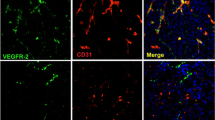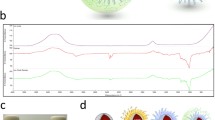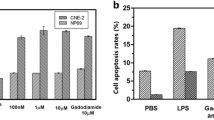Abstract
Purpose
The aim of this study is to monitor endostatin gene expression and therapy using transferrin receptor (TfR) as reporter gene and transferrin conjugate of ultrasmall supramagnetic iron oxide nanoparticle (Tf–USPIO) as magnetic resonance (MR) reporter probe.
Procedure
A retroviral plasmid (pLP-LNCX) encoding mouse endostatin and TfR was constructed, and packaged with a titer of 4 × 107colony-forming units per millimeter. MDA-MB-231 breast tumors were established in BALB/c mice by subcutaneous injection of 2 × 106 MDA-MB-231 cells. Mice were intratumorally injected with recombinant retrovirus and imaged with MR using Tf–USPIO. Western blot, Prussian blue, and immunohistochemical staining were performed to validate the magnetic resonance imaging results. The antitumor effect of retro-endostatin (ES)-TfR was also evaluated by intratumoral injection of the viral vector.
Results
The expression of both endostatin and TfR genes in MDA-MB-231 cells after retroviral transfection was confirmed by Western blot and flow cytometry. Tf–USPIO conjugate binds specifically to cells stably transfected with retro-ES-TfR. After intravenous injection of the Tf–USPIO conjugate, there was a more pronounced decrease in T2 relaxation time in tumors treated with retro-ES-TfR than in tumors treated with empty retrovirus retro-LNCX. The expression of ES gene significantly delayed the growth of MDA-MB-231 tumor and reduction of microvessel density and VEGF level as compared to those without viral transfection or transfected with empty retro-LNCX vector.
Conclusions
Endostatin therapeutic gene expression was visualized successfully using TfR reporter gene and Tf–USPIO MR reporter probe, which indicates that MR reporter gene imaging may be valuable in gene therapy to evaluate therapeutic gene expression and treatment efficacy.




Similar content being viewed by others
References
Carmeliet P, Jain RK (2000) Angiogenesis in cancer and other diseases. Nature 407:249-257
Shojaei F, Ferrara N (2008) Role of the microenvironment in tumor growth and in refractoriness/resistance to anti-angiogenic therapies. Drug Resist Updat 11:219-230
Tozer GM, Kanthou C, Lewis G, Prise VE, Vojnovic B, Hill SA (2008) Tumour vascular disrupting agents: combating treatment resistance. Br J Radiol 81(Spec No 1):S12-S20
Wickstrom SA, Alitalo K, Keski-Oja J (2005) Endostatin signaling and regulation of endothelial cell-matrix interactions. Adv Cancer Res 94:197-229
Li J, Dong X, Xu Z, Jiang X, Jiang H, Krissansen GW et al (2008) Endostatin gene therapy enhances the efficacy of paclitaxel to suppress breast cancers and metastases in mice. J Biomed Sci 15:99-109
Xu HM, Zhang GY, Ji XD, Cao L, Shu L, Hua ZC (2005) Expression of soluble, biologically active recombinant human endostatin in Escherichia coli. Protein Expr Purif 41:252-258
Dhanabal M, Ramchandran R, Volk R, Stillman IE, Lombardo M, Iruela-Arispe ML et al (1999) Endostatin: yeast production, mutants, and antitumor effect in renal cell carcinoma. Cancer Res 59:189-197
Huang X, Wong MK, Zhao Q, Zhu Z, Wang KZ, Huang N et al (2001) Soluble recombinant endostatin purified from Escherichia coli: antiangiogenic activity and antitumor effect. Cancer Res 61:478-481
Hansma AH, Broxterman HJ, van der Horst I, Yuana Y, Boven E, Giaccone G et al (2005) Recombinant human endostatin administered as a 28-day continuous intravenous infusion, followed by daily subcutaneous injections: a phase I and pharmacokinetic study in patients with advanced cancer. Ann Oncol 16:1695-1701
Ning T, Yan X, Lu ZJ, Wang GP, Zhang N, Yang J, et al. Gene therapy in orthotopic lung cancer murine model with angiogenesis inhibitor, endostatin. Hum Gene Ther. 2009. (in press)
Coutinho EL, Andrade LN, Chammas R, Morganti L, Schor N, Bellini MH (2007) Anti-tumor effect of endostatin mediated by retroviral gene transfer in mice bearing renal cell carcinoma. FASEB J 3153–3161
Liu F, Tan G, Li J, Dong X, Krissansen GW, Sun X (2007) Gene transfer of endostatin enhances the efficacy of doxorubicin to suppress human hepatocellular carcinomas in mice. Cancer Sci 98:1381-1387
Waerzeggers Y, Monfared P, Viel T, Winkeler A, Voges J, Jacobs AH (2009) Methods to monitor gene therapy with molecular imaging Methods. 2009. (in press)
Wei X, Lin L, Hou Y, Fu X, Zhang J, Mao Z et al (2008) Construction of recombinant adenovirus co-expression vector carrying the human transforming growth factor-β1 and vascular endothelial growth factor genes and its effect on anterior cruciate ligament fibroblasts. Chin Med J 121:1426-1432
Jin X, Bookstein R, Wills K, Avanzini J, Tsai V, LaFace D et al (2001) Evaluation of endostatin antiangiogenesis gene therapy in vitro and in vivo. Cancer Gene Ther 982–989
Huszthy PC, Brekken C, Pedersen TB, Thorsen F, Sakariassen PO, Skaftnesmo KO et al (2006) Antitumor efficacy improved by local delivery of species-specific endostatin. J Neurosurg 104:118-128
Jiang Z, Teng GJ, Chen BA, Xu ZF, Hu J, Shao ZY (2008) Local effects of retrovirally transduced endostatin-expressing human umbilical cord blood CD34+ cells on transplanted malignancy in a mouse model of hepatic cancer. Cell Transplant 17:969-975
Pawliuk R, Bachelot T, Zurkiya O, Eriksson A, Cao Y, Leboulch P (2002) Continuous intravascular secretion of endostatin in mice from transduced hematopoietic stem cells. Mol Ther 5:345-351
Hu F, Wei L, Zhou Z, Ran Y, Li Z, Gao M (2006) Preparation of Biocompatible Magnetite Nanocrystals for In Vivo Magnetic Resonance Detection of Cancer. Adv Mater Deerfield 18:2553-2556
Zhang C, Jugold M, Woenne EC, Lammers T, Morgenstern B, Mueller MM et al (2007) Specific targeting of tumor angiogenesis by RGD-conjugated ultrasmall superparamagnetic iron oxide particles using a clinical 1.5-T magnetic resonance scanner. Cancer Res 67:1555-1562
Xie J, Chen K, Lee HY, Xu C, Hsu AR, Peng S et al (2008) Ultrasmall c(RGDyK)-coated Fe3O4 nanoparticles and their specific targeting to integrin alpha(v)beta3-rich tumor cells. J Am Chem Soc 130:7542-7543
Mowat P, Franconi F, Chapon C, Lemaire L, Dorat J, Hindré F et al (2007) Evaluating SPIO-labelled cell MR efficiency by three-dimensional quantitative T2* MRI. NMR Biomed 20:21-27
Yamanaka R, Zullo SA, Ramsey J, Onodera M, Tanaka R, Blaese M et al (2001) Induction of therapeutic antitumor antiangiogenesis by intratumoral injection of genetically engineered endostatin producing Semliki Forest virus. Cancer Gene Ther 8:796-802
Wang X, Liu FK, Li X, Li JS, Xu GX (2002) Retrovirus-mediated gene transfer of human endostatin inhibits growth of human liver carcinoma cells SMMC7721 in nude mice. World J Gastroenterol 1045–1049.
Hogemann D, Basilion JP (2002) “Seeing inside the body”: MR imaging of gene expression. Eur J Nucl Med Mol Imaging 29:400-408
Brack SS, Dinkelborg LM, Neri D (2004) Molecular targeting of angiogenesis for imaging and therapy. Eur J Nucl Med Mol Imaging 31:1327-1341
Schäfer R, Kehlbach R, Wiskirchen J, Bantleon R, Pintaske J, Brehm BR et al (2007) Transferrin receptor upregulation: in vitro labeling of rat mesenchymal stem cells with superparamagnetic iron oxide. Radiology 244:514-523
Ichikawa T, Högemann-Savellano D, Saeki Y, Tyminsk E, Terada K, Weissleder R et al. MRI of transgene expression: correlation to therapeutic gene expression Neoplasia. 2002;4:523–530.
Sauter BV, Martinet O, Zhang WJ, Mandeli J, Woo SL (2000) Adenovirus-mediated gene transfer of endostatin in vivo results in high level of transgene expression and inhibition of tumor growth and metastases. Proc Natl Acad Sci USA 97:4802-4807
Moore A, Josephson L, Bhorade RM, Basilion JP, Weissleder R (2001) Human transferrin receptor gene as a marker gene for MR imaging. Radiology 221:244-250
Hogemann D, Josephson L, Weissleder R, Basilion JP (2000) Improvement of MRI Probes To Allow Efficient Detection of Gene Expression. Bioconjug Chem 11:941-946
Moore A, Basilion JP, Chiocca EA, Weissleder R (1998) Measuring transferrin receptor gene expression by NMR imaging. Biochim Biophys Acta 1402:239-249
Thorek DL, Tsourkas A (2008) Size, charge and concentration dependent uptake of iron oxide particles by non-phagocytic cells. Biomaterials 29:3583-3590
Nakase I, Gallis B, Takatani-Nakase T, Oh S, Lacoste E, Singh NP et al (2009) Transferrin receptor-dependent cytotoxicity of artemisinin-transferrin conjugates on prostate cancer cells and induction of apoptosis. Cancer Lett 274:290-298
Inoue T, Cavanaugh PG, Steck PA, Brunner N, Nicolson GL (1993) Differences in transferrin response and numbers of transferrin receptors in rat and human mammary carcinoma lines of different metastatic potentials. J Cell Physiol 156:212-217
Kealy B LA, McMahon JM, Ritter T, O'Doherty A, Hoare M, Greiser U, Vaughan EE, Maenz M, O'Shea C, Barry F, O'Brien T. Comparison of viral and nonviral vectors for gene transfer to human endothelial progenitor cells. Tissue Eng Part C Methods. 2009. (in press)
Evans V, Foster H, Graham I, Foster K, Athanasopoulos T, Simons J et al (2008) Human apolipoprotein E expression from mouse skeletal muscle by electrotransfer of nonviral DNA (plasmid) and pseudotyped recombinant adeno-associated virus (AAV2/7). Hum Gene Ther 19:569-578
Morizono K, Xie Y, Ringpis G, Johnson M, Nassanian H, Lee B et al (2005) Lentiviral vector retargeting to P-glycoprotein on metastatic melanoma through intravenous injection. Nat Med 11:346-352
Blasberg R (2003) In vivo molecular-genetic imaging: multi-modality nuclear and optical combinations Nucl Med Biol 30:879-888
Bhaumik S, Gambhir S (2002) Optical imaging of Renilla luciferase reporter gene expression in living mice. Proc Natl Acad Sci USA 99:377-382
MacLaren D, Toyokuni T, Cherry S, Barrio J, Phelps M, Herschman H et al (2000) PET imaging of transgene expression. Biol Psychiatry 1:337-348
Acknowledgments
This work was supported, in part, by the Foundation of Heilongjiang Educational Committee (10551123), Heilongjiang Technical Plan Project (WC30307), the Key Program of Heilongjiang Scientific Problem Tackling Project (GB04C30201), and the Ministry of Personnel Foundation for Returnees (2007275).
Author information
Authors and Affiliations
Corresponding authors
Additional information
Kai Wang and Kezheng Wang contributed equally to the work.
Rights and permissions
About this article
Cite this article
Wang, K., Wang, K., Shen, B. et al. MR Reporter Gene Imaging of Endostatin Expression and Therapy. Mol Imaging Biol 12, 520–529 (2010). https://doi.org/10.1007/s11307-009-0286-0
Received:
Revised:
Accepted:
Published:
Issue Date:
DOI: https://doi.org/10.1007/s11307-009-0286-0




